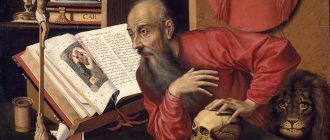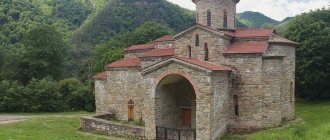Long before the baptism of Russians by Vladimir Svyatoslavovich, the ideas of Christianity began to penetrate into Rus', and according to legend, Andrew the First-Called put a cross on the Kyiv mountains back in the 1st century.
The first Christians began to build the first churches on Slavic lands. Few of them survived their time, but there are also those that still stand in a reconstructed form. Let us turn to the splendor and originality of ancient Russian architecture and present the most ancient Orthodox churches of Orthodoxy.
The oldest Orthodox churches in the world:
Saint Sophie Cathedral. Istanbul
Let's start the story with the main shrine of Orthodoxy. The first wooden church in the market square of the city of Byzantium, later renamed Constantinople, was erected in the period from 324 to 337.
In the first two centuries of its existence, the church was repeatedly destroyed by fires, and only during the reign of Emperor Justinian I in 537 a stone basilica was built from the best marble.
In 1453, after the fall of Byzantium, Hagia Sophia became a mosque, and in 1935, the oldest architectural monument became a museum, but in 2021, Turkish President Tayyip Erdogan reversed the 1935 decision and the building again became a mosque. But for now, Orthodox attributes are still present in this temple.
Russian classicism in Tver off-road
1 / 5
Northern facade of the Church of the Vladimir Icon of the Mother of God in Gornitsy in the Tver region Photo from 1981 from the “Code of Architectural Monuments and Monumental Art of Russia. Tver region". Moscow, 2002
© Public monitoring of architectural, historical and natural monuments of the Upper Volga region “Tver Vaults”
2 / 5
Eastern facade of the church © BankGorodov.RU
3 / 5
Eastern side of the main volume of the church © BankGorodov.RU
4 / 5
Colonnade of the church © BankGorodov.RU
5 / 5
Bell tower © BankGorodov.RU
The theme of manor churches built by the best craftsmen in a distant, and now completely deserted, province is continued by the Vladimir Church in Gornitsy, Tver region. This is the work of one of the most interesting masters of Russian classicism, Nikolai Lvov. From Tver 110 km to Kuvshinovo, from there 20 km to the village of Bor and 3.5 km on foot. The church was built in 1795 by order of Lieutenant Beklemishev. Apart from it and the overgrown park, nothing remains of the estate. The church, hidden in the bushes, is very unusual; its cubic two-tier volume is covered with a gable roof without a dome. The cross was erected above the bell tower-rotunda, placed above the main entrance, but not at the western, but at the southern facade. From the east and west there are equal-sized apses, one of which is an altar. Strictly speaking, the canon is observed, but the composition of the church is confusing: it seems to be rotated 90 degrees.
During the Soviet years, the church was used as a vegetable storehouse, which nevertheless saved it from complete destruction. Then the monument fell into disrepair, the vaults collapsed, and there are no plans for restoration.
Another Lviv masterpiece, the Znamenskaya Church in Teply, Moscow Region, which is collapsing before our eyes, is located in the wilderness, between Klin and Volokolamsk. It is more accessible and in 2007 was included in the alarm list of the World Monuments Fund, which, however, did not yield results.
special PROJECT ABOUT Vladimir CHURCH AND OTHER Abandoned Tver TEMPLES
Music in lost temples: Arzamas' journey to the Tver region
Five stories with video and music
Church of John the Baptist. Kerch
In the very center of Kerch stands the Church of John the Baptist. Today this is the oldest building in Russia.
This unique monument of Byzantine architecture was erected in the 8th century, and in the 12th century several architectural elements were added to the main building.
The age was determined by the inscription on one of the columns of the temple. Architecturally, it is a cross-domed church built in the traditional Byzantine style. The construction used striped white and pink masonry, with the help of which Byzantine architects strengthened the structure in case of an earthquake.
Beautiful decoration with benefit for posterity
A single interior in the architecture of church construction in Ancient Rus' is a distinctive feature of that time. The classic design was low altar partitions, which made it possible to see the upper part of the altar area of the temple.
Each worshiper visually approached the center of the service. For an Orthodox person, it was important to see the divine space that united the earthly and heavenly churches.
The interior decoration of temples in a mosaic style came from the Byzantine tradition. The bright and light decoration symbolizes the unity of the earthly and heavenly.
The temples of Ancient Rus' served as museums, where the relics of saints, icons, and relics with historical value were transferred. Ancient manuscripts and important documents were also transferred here for safekeeping. Thanks to the work of priests and church servants, the history of Ancient Rus' can be traced literally year by year, and many historical events were revealed to contemporaries in the form of indisputable evidence collected in the church.
St. Elias Church. Kyiv
Many historians and archaeologists agree that the Elias Church is the first Orthodox church in Rus'.
During the excavations, the remains of an ancient wooden building were examined; in the chronicle of 945 there is information that a Russian-Byzantine treaty was consecrated in this church.
In 1962, a new single-domed church was erected on the site of a destroyed wooden building. The interior decoration has preserved unique paintings and ancient icons.
Temple in the name of the Holy Apostles Peter and Paul in Smolensk (Peter and Paul Church)
Peter and Paul Church is the oldest in Smolensk. It was built in 1146 under Prince Rostislav Mstislavich, the grandson of Vladimir Monomakh. The inside of the temple was painted with frescoes with floral patterns. Later, the brick floor was covered with majolica tiles, and the walls were decorated with tiles and panels.
During the Time of Troubles, Smolensk was occupied by the Poles, and Catholic services were held in the Peter and Paul Church. It was then that the western extension appeared - the residence of the Polish bishop. The temple was returned to Orthodox parishioners in 1654, when the Poles left the city. The diocese erected a tented bell tower near the western wall.
In the 17th–18th centuries, the third floor was built in the temple, the main nave was expanded and the floor was raised to the level of the first floor of the extension. The church acquired its original appearance only in the middle of the last century.
Today in the Peter and Paul Church you can see fragments of medieval frescoes, ancient colored tiles, as well as rare graffiti - inscriptions from the 12th century.
Read more about the temple in the name of the Holy Apostles Peter and Paul in Smolensk (Peter and Paul Church).
Transfiguration Cathedral. Chernigov
Now let's move directly to the monuments of the times of Kievan Rus. The construction of the five-domed temple in the oldest Russian city of Chernigov began in 1033, but after the death of Mstislav, the architects were sent to Novgorod to build the Novgorod temple.
The construction of the Transfiguration Cathedral was completed only in the 50s of the 11th century. One of the oldest temples in Rus' has reached us in almost its original form.
Today, the three-nave temple is both a functioning church and a museum. The Chernigov-Seversk prince Igor Svyatoslavich, sung in the “Tale of Igor’s Campaign,” is buried in the temple.
Wisdom of God
Sophia of Constantinople, by order of Emperor Justinian, was built by the great architects Anthimius of Trallus and Isidore of Miletus. It was the most grandiose and magnificent building on earth, making an indelible impression on people and thereby confirming the greatness of Orthodoxy and the power of the Byzantine emperor. Large stone buildings were not yet built in Rus' at that time. In addition, the construction of the temple required knowledge of the church canon. Therefore, Yaroslav was forced to turn to the Greeks for help.
Take a wider step: a guide to the historical places of the capital
Where was the first newspaper published, who organized the “electric ball” and what upset actor Yegor Beroev’s Filatov house
It is interesting that by the beginning of the 11th century, wooden churches in honor of Sophia, the Wisdom of the Lord, already existed in both Kyiv and Novgorod. The first one was built by Olga, as stated in the Joachim Chronicle. We know about the second from the text of the First Novgorod Chronicle:
Author of the quote
“Vladyka Bishop Joachim erected the first wooden oak church of St. Sophia, which has the top 13; and stood for 60 years. And she rose from the fire into the summer of March 1049 on the 4th day"
The Kiev temple was burned in 1017 during the princely civil strife that broke out after the death of Vladimir. It is believed that the Poles of Boleslav the Brave, an ally of Svyatopolk who fought against Yaroslav, burned it. Clashes between the brothers continued for many more years, which is why Yaroslav, even after officially becoming the Grand Duke of Kyiv, preferred to live in Novgorod. Only in 1036, after the death of his brother Mstislav, did he finally return to Kyiv. It was then that the prince invited Byzantine craftsmen.
Cathedral_1
St. Sophia Cathedral in Kyiv
Photo: commons.wikimedia.org/Rbrechko
We do not know who they were by origin - no information about this has been preserved. It is reliably known that from 1036 to 1044 foreign craftsmen built several buildings in Kyiv, primarily the Golden Gate and St. Sophia of Kyiv. And then they go north, to Novgorod, to build another temple there in honor of the Wisdom of the Lord.
The eldest son of Yaroslav, Vladimir, was the prince of Novgorod at that time. The chronicle for 1045 says that Prince Vladimir and the masons who arrived from Kyiv
Author of the quote
“The Holy Sophia of Novgorod was founded,” and in 1050 “the Church of Sophia in Novgorod was sacred on the month of September 14 on the Exaltation of the Honorable Cross, by order of the Grand Duke Yaroslav Vladimirovich of Kiev and All Rus' and his son Prince Vladimir Yaroslavich”
Cult of personalities: St. Petersburg Bolshoi Drama Theater and its legends
The names of Blok, Gorky and, of course, Tovstonogov are associated with the history of the theater.
Just 20 days after the consecration of the temple, the still very young Prince Vladimir, who was barely over 30, died suddenly. He became the first to be buried in St. Sophia Cathedral.
Most scientists believe that the initiator of the construction of Novgorod Sofia was not Vladimir, but his father Yaroslav. According to chronicles, he and his wife Irina (Ingigerda - daughter of the first Christian king of Sweden, Olaf Shotkonung) even came to lay the foundation stone for the temple, although the path from Kyiv to Novgorod is not short. “Look, Solomon, I have surpassed you!” - said, according to legend, Justinian, entering Sophia of Constantinople for the first time. Yaroslav did not compete with his predecessors in the size and wealth of the temple, but he was already founding a second Sophia and, apparently, already had in mind a third, which the same team would build in Polotsk. Divine wisdom (this is how Σοφία is translated from Greek) spread throughout Rus', and Prince Yaroslav and his father Vladimir the Baptist stood on a par with the great Christian monarchs and biblical prophets. It is no coincidence that Yaroslav’s associate, Metropolitan Hilarion, in his “Sermon on Law and Grace” describes the baptism of Rus' precisely as the coming of the Wisdom of God, that is, Sophia.
Cathedral_7
View of the St. Sophia Cathedral in Veliky Novgorod
Photo: TASS/Maxim Grigoriev
Author of the quote
“So, rulers of nations, if you delight in thrones and sceptres, then honor wisdom, so that you may reign forever... A multitude of wise men is the salvation of the world, and a wise king is the well-being of the people.”
Solomon calls Divine wisdom “the artist of everything,” “the breath of the power of God and the pure outpouring of the glory of the Almighty,” “the image of His goodness.” This is a continuation of the idea of the ancient Logos or the Talmudic Ruach HaKodesh (Holy Spirit). In Orthodoxy, by the 11th century, a point of view was established that connected Sophia with Christ and the Ever-Virgin. The classic formulation was “Wisdom created a house for herself,” where the house was understood to be the Mother of God, and Wisdom was the incarnate God the Son.
A frivolous genius: how Fyodor Shekhtel changed the face of Moscow
The author of the Yaroslavl station building project never received an architect's diploma
Saint Sophia Cathedral. Kyiv
In recent decades, discussions have not ceased about the time of construction of this masterpiece of ancient Russian architecture. The fact is that one of the graffiti of the church says that it was founded by Prince Vladimir around 1011.
Most likely, the cathedral was founded by Vladimir, and the construction of the unique monument was completed under his son, Yaroslav, in 1037.
The building was badly damaged during Batu's invasion, and during the Ruins it was practically abandoned. Only Hetman Mazepa allocated funds, and St. Sophia Cathedral was reconstructed in the Ukrainian Baroque style. This is how it has survived to this day.
From wood to stone
The abundance of forests in Rus' influenced the predominance of wooden construction. Wood was considered a cheap material, and the difficulty in obtaining building stone also affected its cost.
The history of Ancient Rus' describes that almost all buildings were wooden: towers, palaces, peasant houses, as well as churches. The log was the main element of any structure. Creative projects were limited. Few people dared to undertake desperate experiments in order to spend money on searching for an alternative material. The classic designs of a peasant hut were quadrangular log houses. More complex compositions included princely mansions and tented churches.
It was precisely because of the fragility of the building material that much of the ancient Russian architecture was lost.
Saint Sophia. Novgorod
The main temple of Veliky Novgorod was the spiritual and cultural center of the Novgorod Republic for many centuries.
Arriving in Novgorod in 1046 to visit their son, Yaroslav and Ingigerda (at the baptism of Irina) founded a new temple on the site of the burned church of 989. It took Russian architects four years to build the majestic and unique cathedral.
In the 12th century, the temple was painted with frescoes, and later, in addition to the main altar, two more iconostases were decorated. The building, and along with it the unique paintings and icons, suffered greatly during the Great Patriotic War, but the temple was restored, and today it pleases the eyes of parishioners and thousands of tourists.
✅ We also recommend reading our article about the oldest houses in Moscow.
Temple at the Nizhne-Arkhyz settlement (Northern) in the Republic of Karachay-Cherkessia
The stone temple near Nizhny Arkhyz in Karachay-Cherkessia arose in the 10th century, possibly even before the Baptism of Rus. The capital of the ancient state of Alanya was located in these places - the inhabitants of this city converted to Christianity in 916.
The walls of the temple are built of sandstone, and the roof is lined with thin stone slabs. Under them there was a layer of birch bark - such a technique was not found in any temple in the North Caucasus. Inside, the architects built the only baptismal font in Alanya at that time, and a cemetery appeared behind the temple. The church was dedicated to Saint Nicholas, the heavenly patron of Nicholas the Mystic, who was then the Patriarch of Constantinople.
Throughout its history, the building has never been rebuilt; now it looks the same as it did 10 centuries ago. On the rocks near the temple you can see the face of Jesus Christ written directly on the stones.
Nowadays the temple is empty. Divine services are held here only once a year - on May 6, on the day of remembrance of St. George the Victorious, the most revered saint in the Caucasus.
Read more about the temple at the Nizhne-Arkhyz settlement (Northern) in the Republic of Karachay-Cherkessia.
Church of the Intercession on the Nerl
Among the picturesque Russian expanses, where the Nerl flows into the Klyazma in the middle of the 12th century, at the behest of Prince Andrei Bogolyubsky, a majestic white stone temple was erected.
Both Russian and Byzantine craftsmen took part in the construction, if we refer to the chronicles. The Pokrova stands on a wide water meadow, on a small hillock specially placed for its foundation.
The church itself and its architectural features reflect the building and cultural traditions of pre-Mongol Rus'. This monument of culture and architecture is rightfully included in the UNESCO World Heritage Site. According to the editors of TheBiggest.ru, this is one of the most beautiful temples in the world.
The meaning of the church - from study to royal title
The temples of Ancient Rus' influenced the definitions of surnames, streets, roads, and cities. All objects that were associated with the holy place quickly took on the name of a temple or church.
During the period of Ancient Rus', churches were places of unification. The new settlement began with the construction of a temple - the center of every person's life. Divine services of that time brought together almost all residents of the locality. The important events of each family were the holding of rituals: weddings, baptisms, funeral services, blessings.
The temple played a big role in the Orthodox cult. The decoration of the premises, rituals, and icons gave the believer hope for the salvation of his soul. Moreover, everyone could enjoy the beauty of the temple.
Orthodoxy gave considerable impetus to the development of the arts. Their development took place inside the temples. For a believer, the church was the primary factor in all culture and worship. That is why some important events not related to church life took place under the dome of the shrine. These include: anointing kings on the throne, unction, announcement of the royal decree. We should not forget about the important role of churches in teaching people literacy.
Acting as a social phenomenon in the life of the people of Ancient Rus', monasteries and churches were places where education was organized, archives, workshops, and libraries were located. A little later, from the 19th century, the first schools at that time, parochial schools, began to be established.
Spassky Cathedral of the Andronikov Monastery. Moscow
Founded in 1357 and partially preserved to this day, the Spassky Cathedral is the oldest monument of Russian architecture.
The great Russian icon painters Andrei Rublev and Daniil Cherny took part in painting the walls. Fragments of their work are preserved on the slopes of the temple windows.
The Cathedral of the Andronikov Monastery was rebuilt several times, and acquired its modern appearance already in the 60s of the last century. During archaeological excavations on the territory of the monastery, it was possible to discover structural details of the ancient throne and burial.
An architect's view
Construction techniques for roofing give stone architecture a touch of wooden architecture. This is especially expressed in examples with temple buildings. Roofs continued to be made gable and hipped.
In small villages where modest churches were built, the masonry was carried out like a peasant hut, with a crown (four logs) as the basis. When connected, they formed a square or rectangle. The result was a structure made from a certain number of crowns - a log house.
Churches were built of a more complex design, but according to a given principle. The quadrangular frame was changed to an octagonal frame. The principle of combining quadrangles and octagons passed into the stone architecture of Rus' and has been preserved to this day.
Tent temples are common in Rus' as two- and multi-tiered structures. To connect individual log houses, they were connected to each other by a system of passages (galleries, porches).
By placing church buildings on stone plinths, the builders placed basements, cellars and underground passages that were relevant for that time under the ceilings that went into the ground.
Assumption Cathedral. Moscow
If we consider the oldest churches in Moscow, the first stone cathedral was the Assumption Cathedral, founded back in 1326. But the first building had to be dismantled due to disrepair and design errors.
During the reign of Ivan III in 1471, construction began on a new building, for the construction of which craftsmen from Italy were invited. In 1479, the Church of the Assumption of the Blessed Virgin Mary was solemnly consecrated.
Today, the religious building in the courtyard of the Moscow Kremlin is a museum, and only sometimes, with the blessing of the patriarch, services are held within the walls of the cathedral.
Italian Renaissance in the Tver region
1 / 4
Krasnokholmsky St. Nicholas Monastery. Postcard from the early 20th century humus.livejournal.com
2 / 4
St. Nicholas Cathedral and bell tower. Beginning of the 20th century Krasnokholmsky St. Nicholas Bishop's Metochion
3 / 4
Cell building. Beginning of the 20th century Krasnokholmsky St. Nicholas Bishop's Metochion
4 / 4
Gateway Church of the Ascension. Beginning of the 20th century Krasnokholmsky St. Nicholas Bishop's Metochion
The Krasnokholmsky Anthony Monastery was founded in 1461 by the desert dweller Anthony: he erected a chapel here “for food” and a cell “for repose.” The Uglich prince Andrei Bolshoi fell in love with the modest monastery, and 20 years later the construction of the white-stone cathedral began. Its details and designs may indicate that an Italian master from among the first Fryazins, i.e. Italians, who arrived in Moscow during the reign of Ivan the Third participated in the construction. Ivan the Third (1440–1505) - Grand Duke of Moscow from 1462 to 1505 year, sovereign of all Russia.. The great Aristotle Fioravanti was even suspected of authorship: it is unknown what he was doing during these years. According to another version, the St. Nicholas Church was built by an unknown Russian master, familiar with the latest trends.
1 / 9
Krasnokholmsky St. Nicholas Monastery. 2013 © Dmitry Klushantsev / CC BY-SA 3.0
2 / 9
Ensemble of the Krasnokholmsky St. Nicholas Monastery © Krasnokholmsky St. Nicholas Bishop's Compound
3 / 9
St. Nicholas Cathedral. 2012 © Dmitry Klushantsev / CC BY-SA 3.0
4 / 9
Frescoes of St. Nicholas Cathedral © Krasnokholmsky St. Nicholas Bishop's Compound
5 / 9
Portal of St. Nicholas Cathedral © Krasnokholmsky St. Nicholas Bishop's Compound
6 / 9
Capitals of the columns of the southern portal of St. Nicholas Cathedral © Krasnokholmsky St. Nicholas Bishop's Compound
7 / 9
The fraternal small building above the passage gates of the monastery © Krasnokholmsky St. Nicholas Bishop's Compound
8 / 9
Gateway Church of the Ascension © Krasnokholmsky St. Nicholas Bishop's Compound
9 / 9
North-eastern tower of the monastery © Krasnokholmsky St. Nicholas Bishop's Compound
In the 1930s, the most valuable part of the complex was damaged - they say that a collective farm tractor, either deliberately or accidentally, demolished the altar of the cathedral, and then the vaults collapsed. At the same time, the refectory and the church built in 1494 were destroyed. But even untouched buildings of the 17th century - a patterned gate temple, rich cells and a fence tower - would be enough to make the monastery an adornment of the Tver region. This is not even a wilderness - the monastery is located on the outskirts of the regional center of Krasny Kholm, the P-84 highway passes by, and there is a railway station nearby. It’s surprising that they remembered the abandoned monastery only in 2014, when the dilapidated ruins were transferred to the jurisdiction of the Russian Orthodox Church.
1 / 2
Scaffolding and protective roofing over St. Nicholas Cathedral. 2018 © Nachinanie / Project for the revival of the St. Nicholas Monastery
2 / 2
Forests in St. Nicholas Cathedral. 2021 © Nachinanie / Project for the revival of the St. Nicholas Monastery
In September 2021, the first liturgy was held in the cathedral, of which three walls with fragments of 17th-century frescoes remained. Scaffolding was erected and a temporary roof was laid, but only the state can undertake the restoration of such a large-scale and unique object. The community is now raising money to prepare the documents needed to apply for government funding.
The ruins of another ancient monastery by an unknown author can be seen in the Vologda region: the Korniliev-Komelsky monastery belongs to no one; the remains of the refectory chamber of the 1630s remain from the monastery destroyed in the 1930s.









